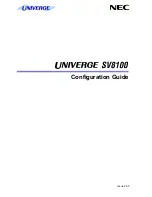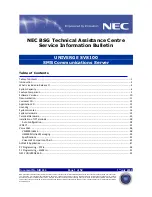
6-18 Troubleshooting
POST fails to complete:
!
Is the DIMM board installed?
– At least two DIMM boards are required for operation.
!
Is the memory size large?
– The memory check may take a few seconds if the memory size is large. Wait for a while.
!
Did you perform any keyboard or mouse operation immediately after you started the
server?
– If you perform any keyboard or mouse operation immediately after start-up, POST may
accidentally detect a keyboard controller error and stops proceeding. In such a case, restart
the server. Do not perform any keyboard or mouse operation until the BIOS start-up
message appears when you restart the server.
!
Does the server contain appropriate memory boards or PCI devices?
– Operation of the server with unauthorized devices is not guaranteed.
Fail to access internal or external devices (or such devices fail to operate):
!
Are cables properly connected?
– Make sure that the interface cables and power cord are properly connected. Also make
sure that the cables are connected in the correct order.
!
Is the power-on order correct?
– When the server has any external devices connected, power on the external devices first,
then the server.
!
Did you install drivers for connected optional devices?
– Some optional devices require specific device drivers. Refer to the manual that comes with
the device to install its driver.
!
Is BIOS configuration correct?
– When the server has PCI devices connected, make sure to set the PCI device interrupts and
others with the BIOS setup utility of the server. (Most PCI devices generally do not require
any change to the configuration, but some boards do require specific settings. Refer to the
manual that comes with the board for details to make correct settings).
<Menu to check: [Advanced] - [PCI Configuration] - [PCI Slot n] - [Option ROM
Scan] n: PCI slot number>
– Some devices connected to the serial or parallel port may require I/O port address or
operation mode settings. Refer to the manual that comes with the board for details to make
correct settings.
<Menu to check: [Advanced] - [I/O Device Configuration]>
Summary of Contents for EXPRESS5800/120MF
Page 1: ... EXPRESS5800 120Mf U s e r s G u i d e ...
Page 2: ......
Page 4: ......
Page 12: ...x ...
Page 24: ...1 6 System Overview Rear View 11 9 10 12 13 14 15 16 2 17 15 18 17 16 1 8 7 6 1 2 3 4 5 2 5 1 ...
Page 58: ...1 40 System Overview This page is intentionally left blank ...
Page 59: ...Chapter 2 Setting Up Your Server This chapter describes how to set up your server ...
Page 202: ...4 62 Installing the Operating System and Utilities This page is intentionally left blank ...
Page 214: ...5 12 Maintenance This page is intentionally left blank ...
Page 229: ...Troubleshooting 6 15 Memory modules DIMM Group 3 DIMM Group 2 DIMM Group 1 ...
Page 304: ...7 50 Upgrading your Server This page is intentionally left blank ...
Page 305: ...Chapter 8 Internal Cabling Diagrams Internal cable connections of the server are shown below ...
Page 318: ...B 4 IRQ and I O Port Address This page is intentionally left blank ...
Page 326: ...C 8 Installing Windows 2000 This page is intentionally left blank ...
Page 340: ...10 Glossary This page is intentionally left blank ...
Page 345: ...xx ...
Page 346: ... ...















































